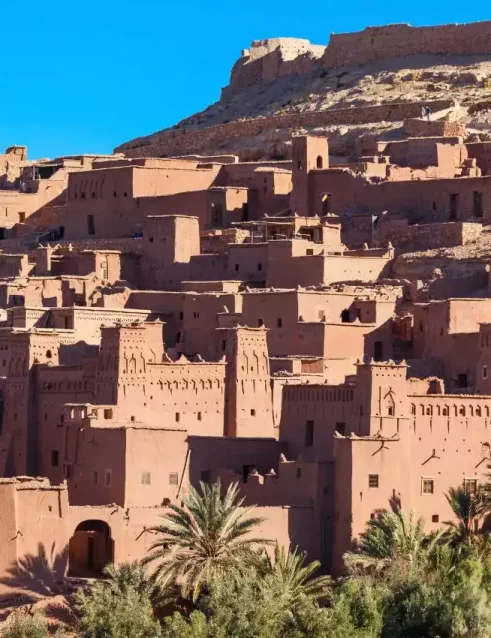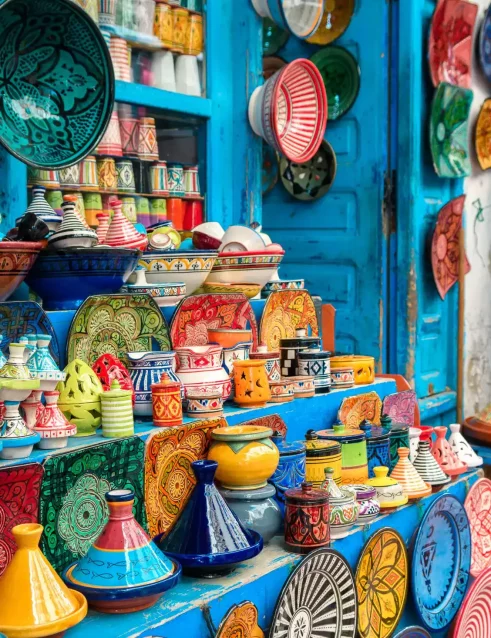Fes El Bali

The cultural and spiritual richness of Fes el Bali is evident in its longstanding establishments like the Kairaouine University, one of the oldest existing and continually operating educational institutions in the world. The vibrant souks are filled with artisan products including perfumes, spices, lamps, and the city’s famous leather goods. Notable landmarks, such as the iconic Blue Gate, Bab Bou Jeloud, mark the entry to this pedestrian-only zone, inviting visitors to step back in time.
Significant expansion and development throughout the centuries have contributed to the medina’s current size. Predominantly during the reign of the Almoravids and Almohads, the city was unified under one fortification, which later further expanded under the Merinids. The historical depth of Fes el Bali is not only composed of its majestic architecture and narrow passages but also its ongoing role as a living monument of Moroccan heritage and daily life.
History and Origin
Fes el Bali, nestled within the vibrant Moroccan city of Fez, stands as one of the most illustrious examples of a medieval Arabic city. This district is renowned for its historic significance and cultural heritage.
Founded during the late 8th century, Fes el Bali’s inception is credited to the Idrisid dynasty. The strategic decision to establish Fez as the capital between 789 and 808 AD laid the foundation for the district’s longstanding importance in Moroccan history. The walls that encircle Fes el Bali not only served for protection but also marked the boundaries of what would become a thriving spiritual and educational hub.
The Medina of Fez, integral to Fes el Bali, is distinctive for its intricate maze of narrow streets and alleys, some of which have remained unchanged since medieval times. Here one finds a plethora of historic buildings, including madrasas, fondouks, palaces, residences, mosques, and a renowned university, Al Kairaouine, one of the oldest in the world.
In 1981, recognizing its unique cultural value, UNESCO designated Fes el Bali, alongside Fes Jdid, as a World Heritage Site. This accolade acknowledges the district’s role in the conservation of traditional urban structure that has endured generations.
| Key Facts | Description |
| Established | Between 789 and 808 AD |
| Dynastic Origin | Idrisid Dynasty |
| Notable Site | Medina of Fez |
| UNESCO World Heritage Site | Inscribed in 1981 |
| University | Al Kairaouine (one of the world's oldest) |
| Notable Features | Historic madrasas, mosques, and a complex urban street network |
Today, Fes el Bali remains a living monument to Morocco’s rich past, abundant in historical treasures that continue to tell a story of a bygone era in the annals of Moroccan history.
Architecture and Design
The architecture of Fes el Bali seamlessly blends its rich history with diverse cultural influences, reflecting a unique heritage within its ancient walls. This area, known specifically for its intricate and traditional Moroccan design, has been the cradle of numerous dynasties, each leaving their distinct mark on its architectural identity.

Influences and Styles
The Medina of Fes, the oldest part of the city, distinctly showcases a mix of Oriental, Andalusian, and African influences. These are evident in the use of geometric designs, ornate tile mosaics known as zellige, and intricate woodwork. The city’s architecture often features key Moroccan elements such as horseshoe arches and riads—traditional Moroccan houses with interior gardens. Fes el Bali Morocco further distinguishes itself with its red sandstone buildings and labyrinthine alleyways, which have remained relatively unchanged since medieval times.
Notable Landmarks
Among Fes el Bali’s most renowned landmarks, the Kairaouine Mosque and University stands out as a testament to Islamic architecture. With a history dating back to 859 AD, it is not only the spiritual center of the medina but also considered one of the oldest continuously operating universities in the world. Another notable structure is the Bou Inania Madrasa, known for its exquisite Marinid architecture, complete with beautiful wood carvings and detailed plaster work. These landmarks, among others, contribute to the medina of Fes’s status as a UNESCO World Heritage Site and offer insight into the storied past of this unique Moroccan city.
Cultural Significance
Fes el Bali, as the oldest walled part of Fez, Morocco, serves as a living testament to a thriving culture steeped in history and tradition. Renowned for its rich tapestry of crafts and trades, as well as vibrant festivals and events, it embodies the heart of Moroccan heritage.
Crafts and Trades
In Fes el Bali, the traditional Moroccan crafts and trades are not only preserved but also practiced with a fervor that has sustained them through the centuries. The medina of Fez is famous for:
- Pottery and Ceramics: Artisans in Fes el Bali continue to create intricate ceramic pieces, often featuring the cobalt blue for which Fez pottery is renowned.
- Leather Goods: The tanneries of Fez are some of the oldest in the world, producing high-quality leather using methods that have changed little since medieval times.

Festivals and Events
Fes el Bali is the epicenter of numerous festivals and events that showcase the region’s commitment to cultural preservation. Notable among these are:
- Fez Festival of World Sacred Music: This annual festival draws performers and audiences from across the globe, celebrating spiritual and artistic traditions.
- The Moussems: These are traditional festivals, often of a religious nature, celebrating the saints of the region and have been rooted in the city’s culture for centuries.
Each of these elements testifies to the enduring cultural significance of Fes el Bali, making it a crucial cornerstone in the historical and contemporary mosaic of Moroccan life.
Economy and Society
The economy of Fes el Bali is deeply anchored in its bustling markets and traditional local businesses which are integral to the cultural heritage of the medina. The economic lifeblood of this ancient quarter is drawn from its artisans and traders, reflecting a society that values its historical legacy while engaging with modern-day commerce.
Markets and Bazaars
In Fes el Bali, the markets and bazaars are a hive of activity. These busy economic centers are famous for their variety of goods, from richly colored spices to fine leatherwork. One of the most renowned bazaars is the tannery, Chouara Tannery, where leather is still processed using centuries-old methods. Visitors can find a labyrinth of stalls selling everything from handcrafted metalwork to vibrant textiles, all reflecting the meticulous craftsmanship of Fes’s artisans.
Local Businesses
The local businesses of Fes el Bali are predominantly family-run and often passed down through generations. These businesses maintain traditional skills and play a crucial role in preserving the cultural identity of the medina. Among these are the Fassi pottery workshops, intricate zellige (tile work) enterprises, and woodcarving studios. Additionally, the University of Al Kairaouine, established in 859 AD, is not only a historical landmark but also a significant educational institution influencing the social fabric of Fes el Bali.
Tourism and Preservation
Fes el Bali, renowned for being one of the most complete medieval cities of the Arab world, attracts a significant number of tourists each year. Its preservation is a model of maintaining the delicate balance between cultural heritage and modern-day demands.

Visitor Attractions
Within the ancient walls of Fes el Bali, visitors can explore a labyrinth of over 9,400 alleyways teeming with historical grandeur. Significant sites include numerous madrasas, vibrant souks, and the Kairaouine Mosque, one of the oldest universities in the world. The medina of Fez is considered the heart of Moroccan culture, offering an immersive experience into traditional Moroccan life.
- Souks: Alive with merchants and craftsmen selling spices, textiles, and pottery.
- Bou Inania Madrasa: Features exquisite zellij tile work and cedar woodcarvings.
Conservation Efforts
Preservation of Fes el Bali is led by strict regulations that oversee architectural modifications to protect its integrity. Such initiatives help educate both locals and visitors on the importance of maintaining Fes el Bali’s historic fabric. A balance is sought to ensure the sustainability of the medina’s cultural legacy while accommodating tourism.
- Regulatory measures: Limits on building renovations maintain the traditional aesthetics.
- Community involvement: Encourages local participation in preservation activities.
Conservation efforts are supported by organizations and agencies, including listing by UNESCO as a World Heritage Site, which recognizes both the historical significance and the need to preserve Fes el Bali for future generations.
Frequently Asked Questions
In this section, you will find targeted information about Fes el-Bali, touching upon its most intriguing aspects from dining experiences to historical and architectural significance.
What are the notable features of the Fes el-Bali Medina?
Fes el-Bali, the ancient walled medina of Fez, is renowned for its labyrinthine alleys and culturally significant architecture. Visitors can explore car-free streets and marvel at ornate entryways like Bab Guissa and the Blue Gate. The medina is also home to the Kairaouine University and the R’cif Mosque, which are significant historical landmarks.
Can you recommend where to eat in Fes el Bali?
Culinary enthusiasts will find a variety of traditional Moroccan restaurants in Fes el-Bali. Each establishment offers a unique selection of local cuisine, from savory tagines to sweet pastries, set within the historic ambiance of the medina.
What is the history behind Fes el-Bali’s urban design related to Islamic worship?
Fes el-Bali’s urban design reflects its Islamic heritage, with mosques and madrasas at the heart of its layout. The medina was built with community and worship in mind, ensuring that residents were always within walking distance of a mosque, facilitating the call to prayer and communal gatherings.
How big is Fes el-Bali?
Fes el-Bali is one of the world’s largest urban pedestrian zones. It encompasses a vast area with a dense network of over 9,400 winding alleyways, creating a unique and expansive environment for both residents and travelers.
How can I navigate the streets of the Fes Medina effectively?
Navigating Fes Medina can be challenging due to its complex network of narrow streets. It is advisable for visitors to employ the services of a local guide or to use a detailed map. Being aware of key landmarks can also assist in orientation within this extensive medina.
What historical significance does Fes hold in terms of its size in the past?
Historically, Fes was one of the most significant cities of the Islamic world, both in terms of size and scholarly importance. Fes el-Bali, in particular, was considered a central hub of education and trade, attracting scholars and merchants from around the globe.









